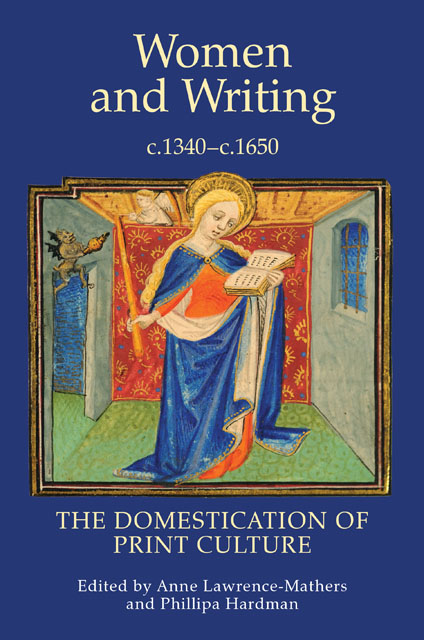Book contents
- Frontmatter
- Contents
- List of Plates
- List of Contributors
- Abbreviations
- Introduction
- Domestic Learning and Teaching: Investigating Evidence for the Role of ‘Household Miscellanies’ in Late-Medieval England
- Domesticating the Calendar: The Hours and the Almanac in Tudor England
- ‘a briefe and plaine declaration’: Lady Anne Bacon’s 1564 Translation of the Apologia Ecclesiae Anglicanae
- Frances Wolfreston’s Chaucer
- Commonplace Book Culture: A List of Sixteen Traits
- Women, Politics and Domesticity: The Scribal Publication of Lady Rich’s Letter to Elizabeth I
- ‘yr scribe can proove no nessecarye consiquence for you’?: The Social and Linguistic Implications of Joan Thynne’s using a Scribe in Letters to her Son, 1607–11
- Fathers and Daughters: Four Women and Their Family Albums of Verse
- The Book as Domestic Gift: Bodleian MS Don. C. 24
- ‘like hewen stone’: Augustine, Audience and Revision in Elizabeth Isham’s ‘Booke of Rememberance’ (c. 1639)
- Female Voices in Early Seventeenth Century Pamphlet Literature
- Select bibliography
- Index
- Misscellanious Endmatter
Commonplace Book Culture: A List of Sixteen Traits
Published online by Cambridge University Press: 01 March 2023
- Frontmatter
- Contents
- List of Plates
- List of Contributors
- Abbreviations
- Introduction
- Domestic Learning and Teaching: Investigating Evidence for the Role of ‘Household Miscellanies’ in Late-Medieval England
- Domesticating the Calendar: The Hours and the Almanac in Tudor England
- ‘a briefe and plaine declaration’: Lady Anne Bacon’s 1564 Translation of the Apologia Ecclesiae Anglicanae
- Frances Wolfreston’s Chaucer
- Commonplace Book Culture: A List of Sixteen Traits
- Women, Politics and Domesticity: The Scribal Publication of Lady Rich’s Letter to Elizabeth I
- ‘yr scribe can proove no nessecarye consiquence for you’?: The Social and Linguistic Implications of Joan Thynne’s using a Scribe in Letters to her Son, 1607–11
- Fathers and Daughters: Four Women and Their Family Albums of Verse
- The Book as Domestic Gift: Bodleian MS Don. C. 24
- ‘like hewen stone’: Augustine, Audience and Revision in Elizabeth Isham’s ‘Booke of Rememberance’ (c. 1639)
- Female Voices in Early Seventeenth Century Pamphlet Literature
- Select bibliography
- Index
- Misscellanious Endmatter
Summary
Work on commonplace books has had a problem with definitions. Sometimes, particularly in library catalogues, the term ‘commonplace book’ is used in an unhelpfully loose sense to describe almost any early seventeenth century manuscript of a miscellaneous character. At other times, scholarly discussion has focused on printed prescriptions – on guides to commonplacing rather than the products of that method. As a result of this concentration on theory, the commonplace book in criticism is a largely disembodied text, a set of ideals rather than enactments. But a quick forage through the archives shows that extant commonplace books rarely conform to such neat templates: commonplace books are, overwhelmingly, messier texts – messier in terms of the kinds of inclusions they present (everything from lines of Ovid to recipes to cure an ailing horse) – and in terms of their material form. The experience of reading manuscript commonplace books is often an experience of baffled delight – delight at pages so crammed with text that annotations spill over to the binding and covers; at devotional aphorisms jostling with bawdy epigrams and recipes (‘Unto the lorde haue I lyfte up my soule’; ‘to preserve plumes or Damsins’); at scraps of printed pages glued into the manuscript; at prose merging with verse merging with financial accounts merging with illustrations; at blank pages, and gaps; at entire printed books bound into the centre of manuscripts; at the construction of a single manuscript out of many different sized pages; at the recycling of old, often medieval texts in the binding of manuscripts; at the steady accumulation of notes by several generations of annotators; at texts that simultaneously ‘begin’ from various points within their pages and proceed in various directions, so that it becomes meaningless to talk of a front or back, a beginning or an end. Because criticism has yet to turn fully to commonplace books in the archives, it has conveyed neither this eclecticism of inclusions nor this rampantly inventive materialism.
In this essay I wish to reconsider the term ‘commonplace book’, and to suggest that the use of the broader category ‘commonplace book culture’ is a helpful way to convey this very wide range of texts and practices.
- Type
- Chapter
- Information
- Women and Writing, c. 1340-c. 1650The Domestication of Print Culture, pp. 90 - 110Publisher: Boydell & BrewerPrint publication year: 2010
- 15
- Cited by



